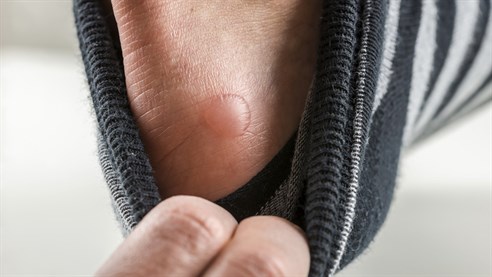Blisters develop to protect damaged skin and help it heal. They’re mostly caused by friction, burns and skin reactions. The most common types of blisters include:
- Blood blisters: caused when something pinches your skin. Instead of clear liquid, blood floods the area from broken blood vessels and damage to the lower layers of the skin. The blood pools and forms a blister.
- Friction blisters: due to rubbing on the skin, friction blisters form when clear fluid builds up in the upper layers of skin. Many people develop friction blisters from walking too much in poor-fitting shoes or by not wearing socks.
- Heat blisters: caused by burns or sunburn. They may also form after you warm up from frostbite. Blistering skin is part of a second-degree burn.

How do I treat blisters?
Blisters generally heal on their own within a few days. To make them more comfortable you can try:
- Washing the area gently with a mild soap.
- Applying antibacterial cream or ointment such as savlon or acriflex.
- Cover the blister with gauze or a plaster. Be sure to change the bandage at least once a day. You could also try blister treatment patches such as compeed (https://www.compeed.co.uk/).
- Resist the temptation to pop or break a blister or peel it off! The skin on the blister protects deeper layers of skin from becoming infected.
How can I prevent blisters on my feet?
You have several options for preventing blisters – most involve preparation and caution.
Most foot blisters result from repeated friction or rubbing of the skin. To prevent them:
- Make sure your shoes fit well and do not rub.
- Break in new shoes before wearing them for extended periods.
- Wear gloves to protect your hands if you plan on doing a lot of manual labor.
- Wear properly fitting clothes to prevent chafing that can lead to blisters on other parts of your body.
You might want to try anti-blister patches such as pellitec (https://pellitec.co.uk/), which you apply to your footwear to reduce the likelihood of blisters firming.
When should I seek help for my blisters?
You should see a healthcare provider such as a podiatrist, doctor or treatment room nurse if your blister does not improve after a few days. You should seek advice if you suspect that the blister is infected – in which case the skin will be red and swollen, and the blister may be filled with a white or yellowish fluid rather than a clear fluid or blood.
For more advice on blister prevention and selecting appropriate footwear you can make an appointment with your podiatrist
